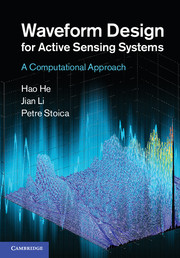Book contents
- Frontmatter
- Contents
- Preface
- Notation
- Abbreviations
- 1 Introduction
- Part I Aperiodic correlation synthesis
- 2 Single aperiodic sequence design
- 3 Aperiodic sequence set design
- 4 Lower bounds for aperiodic sequences
- 5 Stopband constraint case
- 6 Ambiguity function (AF)
- 7 Cross ambiguity function (CAF)
- 8 Joint design of transmit sequence and receive filter
- Part II Periodic correlation synthesis
- Part III Transmit beampattern synthesis
- Part IV Diverse application examples
- References
- Index
8 - Joint design of transmit sequence and receive filter
from Part I - Aperiodic correlation synthesis
Published online by Cambridge University Press: 05 August 2012
- Frontmatter
- Contents
- Preface
- Notation
- Abbreviations
- 1 Introduction
- Part I Aperiodic correlation synthesis
- 2 Single aperiodic sequence design
- 3 Aperiodic sequence set design
- 4 Lower bounds for aperiodic sequences
- 5 Stopband constraint case
- 6 Ambiguity function (AF)
- 7 Cross ambiguity function (CAF)
- 8 Joint design of transmit sequence and receive filter
- Part II Periodic correlation synthesis
- Part III Transmit beampattern synthesis
- Part IV Diverse application examples
- References
- Index
Summary
There has been a long-standing interest in designing radar transmit signals and receive filters jointly for clutter/interference rejection; see, e.g., [Rummler 1967][DeLong Jr. & Hofstetter 1967][Spafford 1968][Stutt & Spafford 1968][Blunt & Gerlach 2006][Kay 2007] and [Stoica, Li & Xue 2008]. Clutter (or reverberation in sonar terminology) refers to unwanted echoes that are usually correlated with the transmitted signal, while interference is a term used for noise as well as (adverse) jamming signals. Since the negative impact from clutter and interference should be minimized at the receiver side, a natural criterion for designing transmit signals and receive filters would be to maximize the signal-to-clutter-plus-interference ratio (SCIR) of the receiver output at the time of target detection.
It is well known that a matched filter maximizes the signal-to-noise ratio (SNR) in the presence of additive white noise (see Chapter 1). The matched filter can be implemented as a correlator that multiplies the received signal with a delayed replica of the transmitted signal. The peak of the receiver output indicates the time delay of the target signal. If the received signal also has a Doppler frequency shift due to the relative movement between the target and the platform, a bank of filters is needed, each of which is matched to a specific Doppler frequency.
A matched filter is not able to take care of clutter or jamming suppression, a feature that is left to the transmit signal design.
- Type
- Chapter
- Information
- Waveform Design for Active Sensing SystemsA Computational Approach, pp. 123 - 146Publisher: Cambridge University PressPrint publication year: 2012



